Physics of the Ollie
Ollie Up!
Introduction
Skateboarders can leap over obstructions and have
their boards follow up over the obstruction with them. They do this
by pushing down on the board!
Forces on the level
Let's start by looking a the forces on the rider
and on the board as she rides level.
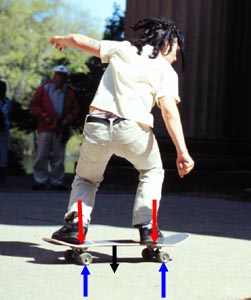
The board is pushed down by the rider (two red
arrows)
Pulled down by gravity. (small black arrow)
And, pushed up by the ground,(two blue arrows.)
The center of mass of the skateboard is in the center of the
board.(where the black arrow touches the board.)
The sum of all the forces on the board is Zero!
There is no acceleration.
The sum of all the torques, twisting forces, on
the board is Zero! There is no angular acceleration.
Forces in the ollie
The forces during an ollie change with time so
we'll explore the forces by looking at several frames of a movie. In
each frame we'll look at the forces on the board.
|
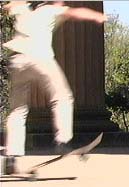
|
Start
The rider is launching herself into the air by pushing
down on the skateboard. Red.
Her rear foot at the back of the board is pushing down
harder than her front foot. Red.
There is a large upward force by the pavement on the rear
wheels. Blue.
Gravity is pulling down on the skateboard. Black.
All of these forces together cause the skateboard to
pivot about the rear wheels . (These forces produce a torque
or twisting force on the skateboard.)
The nose of the skateboard begins to rise, the center of
mass of the skateboard also begins to rise.
|
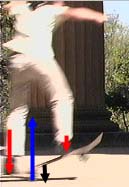
|
|
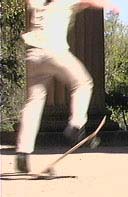
|
0.03 s
The rear of the skateboard collides with the ground.
|
|
|

|
0.06 s
Note that in this photo the rear foot is no longer in
contact with the board. (It could be in contact but it
doesn't need to be.)
The rear wheel is no longer on the ground.
The skateboard is only in contact with the ground at the
rear of the board.
There is a large upward force by the ground on the rear
end of the skateboard. The skateboard is pivoting about this
point of contact.
The skaters front foot is pushing down on the board,
creating a torque and stopping its rapid upward
rotation.
The front foot also uses its friction force with the
rough surface of the board to drag the board upward.
|
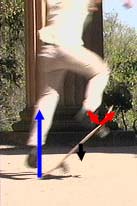
|
|
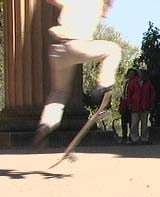
|
0.12s
The board is now completely in the air.
The skaters front foot pushes down on the front of the
board.
Gravity pulls down on the center of mass.
The board's vertical rise is slowing. The front of the
board has stopped rotating up and is beginning to rotate
down.
Notice the bend in the skater's front leg, the leg has
moved upward dragging the board with it.
|
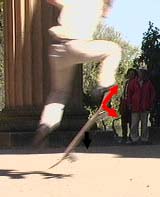
|
|
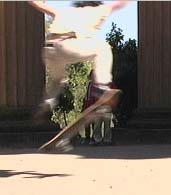
|
0.18s
The nose of the board continues its downward
rotation.
|
|
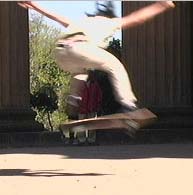
|
0.24 s
Gravity is pulling down, the skaters front foot is
pushing down. Notice how the front leg has straightened.
the board is accelerating downward and is becoming
level.
The skater has placed her rear foot over the board in
anticipation of the iminent collision with the ground. The
skaters rear foot is pushing down on the board stopping the
roatation of the board.
The board is nearly level.
|
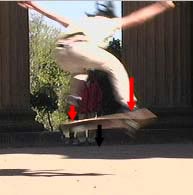
|
|
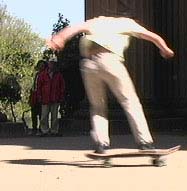
|
0.33s
In one-third of a second it's over.
Both feet of the skater press down on the board.
the pavement pushes up on both sets of wheels.
Gravity pulls the board down.
The board and skater rapidly stop their downward movement
and resume moving at a constant speed.
|
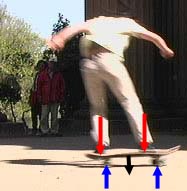
|
Scientific Exploration by Paul Doherty












